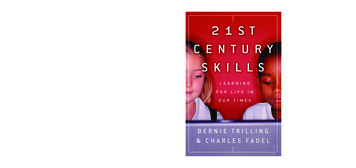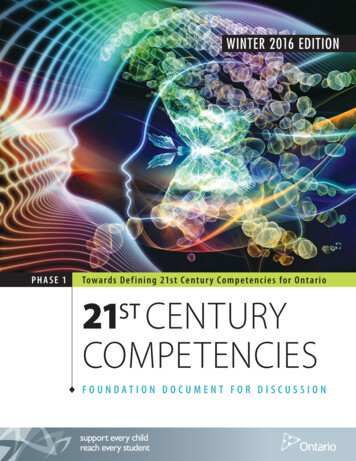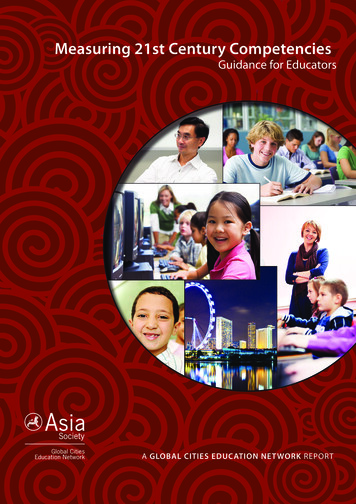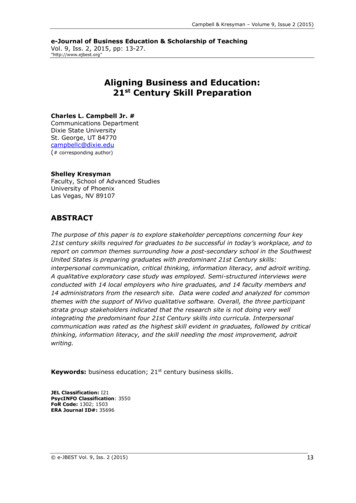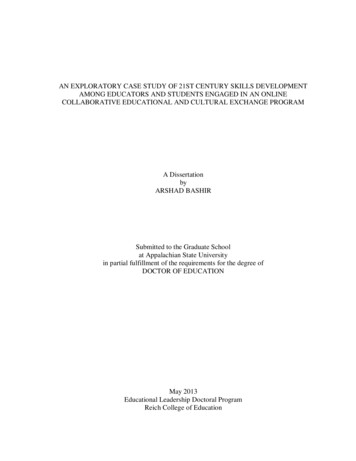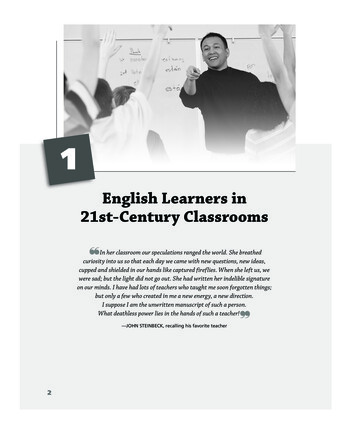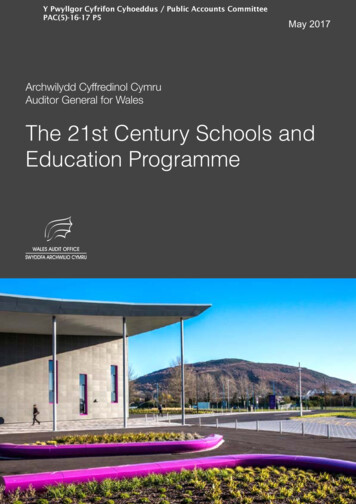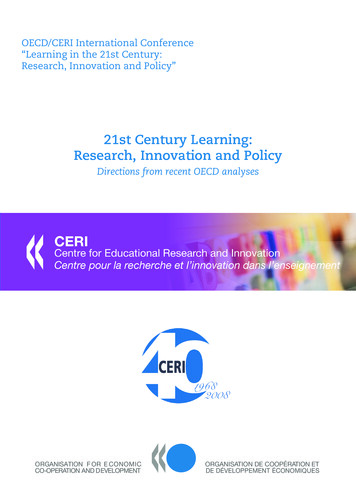
Transcription
OECD/CERI International Conference“Learning in the 21st Century:Research, Innovation and Policy”21st Century Learning:Research, Innovation and PolicyDirections from recent OECD analysesORGANISATIONORGANISATIONF ORF ORE CONOMICE VELOPMENTORGANISATIONORGANISATIONDE COOPÉRATIONDE COOPÉRATIONET ETDE QUES
21ST CENTURY LEARNING: RESEARCH, INNOVATION AND POLICYDIRECTIONS FROM RECENT OECD ANALYSESLearning is central in knowledge-based societies and economies. In many countries there is a push to reflect this byensuring that reforms of the education system focus more strongly on learning itself rather than simply changingstructures and educational organisation. But what does a ‘focus on learning’ mean in concrete terms? Why is itimportant? And crucially, is the knowledge base on learning strong enough to help policy-makers shape their directionof educational change? This paper aims to shed light on these questions and provide directions from recent OECDeducational analyses.Rationales for Closer Focus on Learning and on ChangeThe Need for Lifelong LearningThe inevitability of lifelong learning in knowledge-oriented societies implies that school systemsshould have different objectives and characteristics than if education were considered to have beencompleted when a student leaves initial education. Yet in practice, there remains a tendency for schooleducation to be assessed in terms of the achievements and targets that systems have set themselves, ratherthan their broader success in laying the foundation for lifelong learning.In the knowledge economy, memorization of facts and procedures is not enough for success. Educatedworkers need a conceptual understanding of complex concepts, and the ability to work with themcreatively to generate new ideas, new theories, new products, and new knowledge. They need to be ablecritically to evaluate what they read, be able to express themselves clearly both verbally and in writing, andunderstand scientific and mathematical thinking. They need to learn integrated and usable knowledge,rather than the sets of compartmentalised and de-contextualised facts. They need to be able to takeresponsibility for their own continuing, life-long learning.What PISA has to sayAccording to PISA, school systems are not outstandingly successful in preparing students for thekinds of abilities and skills that build the foundation for lifelong learning. PISA attainments shed light onthis question as they are based on a dynamic model “in which new knowledge and skills necessary forsuccessful adaptation to a changing world are continuously acquired throughout life” (PISA, 2003b), ratherthan measuring achievement in terms of specific curricula. With its focus on reading, mathematical andscientific “literacy”, PISA emphasises the mastery of processes, the understanding of concepts, and theability to function in different situations in each domain, rather than the possession of specific knowledge.1.For instance, in only 5 OECD countries do more than two-thirds of young people reach or surpassPISA level 3 in reading literacy - the level which involves comprehension and interpretation of moderatelycomplex text. (The 5 countries are: Canada, Finland, Ireland, Korea, and New Zealand.) The averageacross OECD countries is 57.1% attaining level 3 or above. In 17 OECD countries, 40% or more do not1.PISA (Programme for International Student Assessment), has measured the outcomes of education systemsat the end of compulsory schooling and related factors every three years since 2000, involving well over1 million 15-year-olds surveyed and over 60 countries.1
achieve at the level 3 threshold in reading literacy, and these low-performing students are in the majority infour of these countries. The countries which have 40% or more achieving at best at level 2 are Austria, theCzech Republic, Denmark, France, Germany, Greece, Hungary, Iceland, Italy, Luxembourg, Mexico,Norway, Portugal, the Slovak Republic, Spain, Turkey, and the United Kingdom. They are the majority ofstudents in Greece, Italy, Mexico, Portugal, the Slovak Republic, Spain, and Turkey. [PISA2006, Chapter6]Regarding problem-solving, around a fifth of the students in all OECD countries in 2003 could beconsidered “reflective, communicative problem-solvers”, who are able to analyse a situation, makedecisions and manage multiple conditions simultaneously, with just under a third being ”reasoning,decision-making problem-solvers” and a third counted as ”basic problem solvers”. This leaves around16 % considered as “weak or emergent problem-solvers”, who are generally unable to analyse situations orsolve problems that call for more than the direct collection of information.Hence, the PISA results provide a prime facie case in that too many students are not well prepared forthe knowledge society in terms of the different literacies and problem-solving abilities. These argumentsare supported by many analysts working in the learning sciences.The Learning Sciences ArgumentWhen learning scientists (Sawyer, 2006) first went into classrooms, they discovered that most schoolswere not teaching the deep knowledge that underlies knowledge work. By the 1980s, cognitive scientistshad discovered that children retain material better, and are able to generalise it to a broader range ofcontexts, when they learn deep knowledge rather than surface knowledge, and when they learn how to usethat knowledge in real-world social and practical settings. Thus, learning scientists began to argue thatstandard model schools were not aligned with the knowledge economy.A set of key findings has emerged from learning sciences research: the importance of learning deeperconceptual understanding, rather than superficial facts and procedures, the importance of learningconnected and coherent knowledge, rather than knowledge compartmentalized into distinct subjects andcourses, the importance of learning authentic knowledge in its context of use, rather than decontextualizedclassroom exercises and the importance of learning collaboratively, rather than in isolation.Traditional models of schooling which are not in line with these key findings and, so runs thisargument, are thus not well suited to our knowledge economies and societies. Therefore, learning scientistsare calling for a change of today‟s schools.The Call for New Approaches from „Schooling for Tomorrow‟A radical change with a strong focus on learning has not only been called for by learning scientists,but also by some very near to policy-making at different times in the Schooling for Tomorrow programme.The keynote address of Michael Barber to the 2000 Rotterdam Conference, for instance, argued from newdriving forces to new models in the following terms:The explosion of knowledge about the brain and the nature of learning, combined with thegrowing power of technology, create the potential to transform even the most fundamental unit ofeducation - the interaction of the teacher and the learner. Moreover, huge social changes, such asgrowing diversity and population mobility, present educators with new and constantly changingcircumstances. As a result, the characteristics which defined the successful education systems of,say, 1975, are unlikely to be those which will define success in the future. (OECD 2003a: 115)2
More recently, the need to search for new approaches was articulated forcefully in the conclusions ofthe Toronto Schooling for Tomorrow Forum in June 2004, especially by one of the Canadian rapporteurs,Raymond Daigle:For the past 15 years or so, a number of industrialised countries have been implementingsweeping and costly reforms. Although there was some real initial progress, these reforms haveultimately come up against a wall, or rather a ceiling, beyond which further progress seemsimpossible, leading increasing numbers of school administrators and educators to wonderwhether schools do not need to be reformed but to be reinvented. (OECD 2006a: 187-188)Like Barber‟s focus on the interaction of teacher and learner, Daigle talks about the micro level – theorganisation of teaching and learning in the place we call „the school‟. He does not suppose that „theschool‟ is necessarily an institution of formal schooling; for if it is to be reinvented it can refer to allnumber of arrangements through which organised, deliberate learning might take place.The views of these particular commentators of the need for different approaches to education –„reinvention‟ in Daigle‟s words – share the fundamental belief and are in line with the argument of thelearning scientists that the most fruitful area to search for new approaches will lie in close attention to thenature of learning itself.Insights from CERI and Related OECD Studies on LearningThere have been a number of projects in the Education Directorate of the OECD and in CERI inparticular that give insights on learning and provide directions for educational change that is focussing onlearning. The projects and their main findings will be presented in this section.The Neuro-scientific Study of LearningThe purpose of the CERI project on “Learning Sciences and Brain Research” was to encouragecollaboration between learning sciences and brain research on the one hand, and researchers and policymakers on the other hand. It has produced two important publications (see: OECD 2002 and 2007), as wellas resulted in intensive collaboration, networking and dialogue.On many questions, neuroscience builds on the conclusions of existing knowledge from other sources,such as psychological study, classroom observation or achievement surveys. But the neuro-scientificcontribution is important as it opens up understanding of „causation‟ not just „correlation‟ and so can helpidentify effective interventions and solutions. Neuroscience is also generating new knowledge, opening upnew avenues. Without understanding the brain, for instance, it would not be possible to know aboutdifferent patterns of brain activities, e.g. why certain learning difficulties are apparent in particular studentseven when they seem to be coping well with other educational demands.The understanding of literacy in the brain is one important area where brain research can informreading instruction. The dual importance in the brain of sounds and phonological processing, on the onehand, and the direct processing of semantics or meanings, on the other, can inform the classic debatebetween top-down and bottom-up approaches – “whole language” text immersion and the development ofphonetic skills, respectively. Learning sciences have also charted the inverse relationship between age andthe effectiveness of learning many aspects of language – in general, the younger the age of exposure, themore successful the second- or third-language learning. This is at odds with the education policies ofnumerous countries where foreign language instruction does not begin until adolescence. This is a goodexample where learning science confronts educational practice to ask whether attention to the evidencebase calls for significant change to conventional practice.3
The study of the brain also highlights the importance of emotions. Emotional states induced by fear orstress directly affect learning and memory. Brain studies have illuminated how negative emotions blocklearning and have identified the amygdala, the hippocampus and stress hormones, as playing a crucial rolein mediating the effects of negative emotions on learning and memory. Some level of stress is essential foroptimal adaptation to environmental challenges and can lead to better cognition and learning, but beyondthis modicum it activates responses in the brain associated with flight and survival and inhibits thoseresponsible for analytical capacity. Hence if the student is faced with sources of stress in an educationalcontext which go beyond the positive challenge threshold – for instance, aggressive teachers, bullyingstudents, or incomprehensible learning materials whether books or computers – it triggers fear andcognitive function is negatively affected. Therefore, it might end up showing that concepts which placeemotional factors to the fore in various forms of “alternative schooling”, which had previously beengrasped intuitively or philosophically, may in fact have very sound neuro-scientific underpinnings.One of the most surprising elements to emerge from the recent report on „Understanding the Brain‟concerns the more general, practical issue of how the science of learning should be applied in education.Beyond informing general policy and practice, the eventual application of the results of neuroscience toindividual learners may be highly beneficial in order to find out such matters as whether a student reallydoes comprehend certain material, or about their levels of motivation or anxiety. Used properly, thisindividual focus may add fundamentally powerful diagnostic tools to the process of formative assessmentand personalised learning, as discussed above. At the same time, studies of the brain show that individualcharacteristics are far from fixed – there is constant interaction between genetic function and experienceand plasticity, such that the notion of an individual‟s talents/capacity – as if this were fixed and open toscientific scrutiny - should be treated with considerable caution.Personalised learningThe aim of “personalising learning” is of growing prominence in thinking and policy discussion insome countries. It springs from awareness that “one-size-fits-all” approaches to school knowledge andorganisation are ill-adapted to individuals‟ needs and to the knowledge society at large. This emerging ideais that systems capable of achieving universally high standards are those that can personalise theprogramme of learning and progression offered to the needs and motivations of each learner.Personalisation can mean adopting a more holistic, person-centred approach to learner development, aswell as more demand-driven, market-friendly approaches to system change. In part, it reflects a change insocial climate, driven by the affluence and value change that arise from sustained economic growth.The degree of interest is reflected in the recent OECD/CERI publication, “Personalising Education”,[OECD, 2006(b)]. Sanna Jarvela‟s contribution to that volume summarises some of the findings ofresearch into the nature of learning and aims for education, which the personalisation agenda addresses: Collaborative efforts and networked forms of expertise are increasingly needed in the futureknowledge society. Students need to be able to develop their personal learning needs and individual expertise in theareas which they either feel incompetent or they want to increase their existing expertise. Curiosity and creativity are increasingly essential. Learning is developed through explicit learning strategies, learning to learn skills, technologicalcapacities for individual and social learning activities, and through learning communities withcollaborative learning models.4
Learning needs to be sensitive to contextual conditions, different values and cultural features. When technology is seen as an intelligent tool for supporting individual learning, as well ascollaborative learning among different individuals, there are multiple ways to expand potential inevery student.Assessment for Learning - Formative AssessmentAssessment for learning may be viewed as an essential element of more personalised approaches toeducation. It refers to assessment of student progress that is an ongoing part of everyday teaching, ratherthan a special event. Like other approaches which place learning at the centre – such as mastery learning orintensive tutoring – they have been associated with significant gains in achievement. As well as promisingto raise standards, such approaches address equity head on. They do so through the individualisation ofteaching and learning strategies and through the continual identification of and responses to students whoare experiencing difficulties. Moreover, these approaches are explicitly about developing cultures oflearning in schools and classrooms. Yet, they receive far less prominence than conventional forms ofassessment such as achievement tests and examinations which are much more in the “one-size-fits-all”mode. All this helps to explain the interest of formative assessment to CERI (OECD 2005a).Formative assessment is designed to provide teachers and students with critical information aboutlearning needs, help students to assess their progress towards learning goals, and guide teachers to varytheir teaching according to needs and goals. It can include data from a number of sources such asclassroom interactions, as well as more conventional forms of assessment such as tests and examinations. Itprovides ways of responding to the aims of enhancing learning and augmenting teacher professionalismrather than assuming that the act of assessment itself, providing summary measures of achievement levels,is tantamount to improvement. Some of the core methods and practices of formative assessment are usefulto note as potentially framing elements in enhancing the role of learning in innovation.“New Millennium Learners”The CERI project entitled “New Millennium Learners” investigates the effects of digital technologieson school-age learners. The project examines the characteristics of learners and the impact of theirsustained use of digital devices and services. Surprisingly little is known about the effects of technologieson cognitive skills, outside of areas related to visual-spatial skills and nonverbal forms of intelligence. Theinfluence of technology use on reasoning capability and judgment has been shown to be relatively small,while there are many studies regarding the influence of technology use on abilities related to informationprocessing, reflective and critical thinking, creativity and, in general, meta-cognitive skills. However, noresearch review has documented a positive effect yet on the basis of empirical research. It may be that thisshows the need for a “neuroscience of children and media” intended to research the impact of digital mediaon children‟s brain development, a need that has only been expressed very recently (C.A. Anderson, 2007).Studies carried out with pre-adolescent children so far seem to indicate the importance of two factors:first, the impulse to experiment and discover, and the consequent lack of fear, that characterises theexploratory behaviour of children at a young age; and second, the predisposition to emulate adults‟behaviour. The latter relates in turn to the issue of gender differences of technology use and the consequentimpact this might have in education, both at home and in schools. Hence the relevance of this work forenhancing creativity – the natural dispositions of young people to experiment with ICT – alongsideconstraining factors (in this case the role models provided by too many adults and the discouragingcultures of too many schools).5
An issue of competing policy discourses has been identified in the work of “New MillenniumLearners”. On the one hand, there is the discourse which claims that the real educational benefits of usingICTs are to be seen in domains such as team-working, creativity, problem-solving and the like, in waysvery close to the subject of this paper. Yet so long as these are not central to (or even recognised in!)assessment systems such as national examinations, the potential for realising such benefits will always beseverely constrained. The second discourse focuses on the factors with a demonstrated impact on boostingeducational performance as measured in existing national and international surveys. And, as yet, there isinsufficient evidence that ICT use does have an incontrovertible impact on standards so undermining, forthose wedded to this discourse, the educational arguments for imaginative ICT use in schools.However, no-one should expect each and every use of ICT to have a positive learning impact –focusing the question back onto the ways in which ICT is used, in which circumstances, for which studentsetc – and asking for incontrovertible evidence of the benefits of ICT in a learning society may be no moresensible than to ask for the evidence about the value of books before buying any for schools.PISA on Approaches to LearningThe PISA findings show that there is a positive association between students‟ performance and theirapproaches to learning, such as their motivation to learn, their beliefs about their own abilities and theirlearning strategies. These learning approaches are not only associated with success but can also be viewedas an educational outcome on its own: once students leave school, they have to manage most of their ownlearning. To do this, they need to be able to establish goals, to persevere, to monitor their learning process,to adjust their learning strategies as necessary and to overcome difficulties in learning. Students who leaveschool with the autonomy to set their own learning goals are better equipped to become successful lifelonglearners. PISA shows that there is a large variation in learner characteristics among students in each school.Relatively few schools succeed in promoting particularly strong approaches to learning among theirstudents. This underlines the importance for schools and teachers to be able to engage constructively withheterogeneity not only in student abilities but also in their characteristics as learners and their approachesto learning.PISA shows how important positive approaches to learning are for successful and lifelong learning.As argued above, they give rise to concern that many countries are not well prepared for the knowledgesociety in terms of the literacy and problem solving abilities of their next generation. Thus it is legitimateto ask the question, if the traditional way of learning in many countries, is adequate for the 21 st centuryworld.Exemplary Designs for LearningThe OECD‟s Programme for Educational Building (PEB) periodically conducts a selection ofeducational designs to help the planners of educational facilities know what is possible through showcasingleading international examples (OECD 2006c). The international PEB jury chooses the facilities featuredin the publication for their fitness for educational purpose, with the new designs fitting one or more of thecriteria described below. The facilities‟ construction, design or use is judged to be noteworthy and tocontribute to educational quality. Included are newly built or renovated buildings, extensions or grounds.Flexibility is the main criterion used which is of interest to this report. This is understood to mean thatbuildings or grounds are adapted to new forms of learning and research; institutions that make special useof information and communications technology; or special educational facilities. Characteristics includetransformable learning spaces, student-centredness, problem-based learning facilities, or provision forstudents with physical, learning or behavioural difficulties or for “at-risk” students (those whoseeducational needs arise primarily from socio-economic, cultural or linguistic factors).6
There are other criteria considered by the jury. One is community needs: institutions that encouragecommunity involvement and/or access by giving multiple stakeholders the opportunity to participate intheir design, planning or day-to-day management; by catering to lifelong learning; or by sharing thefacilities with students‟ families or others. Another is sustainability: facilities that demonstrate specialconsideration for the environment through the efficient use of energy, choice of materials, local or naturalresources, siting or management. Safety and security is a further criterion, as is alternative financing, ofcapital expenditure (including the use of private financing), or buildings whose life-cycle costs aresustainable.Educational Reform and InnovationEducational reform and the concept of innovation are clearly related to the search after newapproaches to learning. If a school is to change so that its approach to learning is significantly differentfrom what went before it will often need innovation.Innovation and Knowledge ManagementMany studies have argued for more flexible, open forms of learning and of school organisation butwhile it is not difficult to identify numerous promising examples, it is not so easy to find evidence of moresustained and widespread change. A variety of the factors inhibiting fundamental change to traditionalpractices has been analysed in OECD/CERI work on knowledge management (OECD 2000a;OECD, 2004a). This suggests that, in general, schools have weak networking and knowledge-sharingamong teachers. Spending on educational research and development is very low in contrast to other sectorsof activity characterised by the intensive creation and use of knowledge and the application of the R&D isquite limited. Most of the professional knowledge that teachers use in their daily work is tacit: it is rarelymade explicit or shared with colleagues. Schools and classrooms are normally isolated one from anotherrather than interlinked. In short, the message is that too many schools still tend to have only rudimentaryknowledge management practices, despite knowledge being education‟s explicit business.Reform and InnovationWhat is the relationship between reform and innovation? It would be too simple to contrast theenterprise of reform as something directed from the centre and necessarily flawed in contrast with thevalue of grass-roots innovation. The encouragement of innovation as something isolated might even be away of diffusing the pressure to change, as Maria Roldau maintained in an earlier „Schooling forTomorrow‟ volume reflecting on 1990s Portuguese developments:The “culture of the experiment”, conceived and experienced as an exception to the general rulethat remains otherwise untouched, made its way deeply into schools and teachers‟professionalism This idea of doing “good experimental things” means predominantlysomething interesting and innovative that affects only some people in the school or segment ofthe system but not the routines and the largely dominant practices of teachers and schools.(OECD 2003: 89-90)Hence, there is need to understand more profoundly the nature of innovation and to focus on itsencouragement and sustainability, even bureaucratisation, rather than just gather examples of innovativepractice as if by themselves they might inspire a profound change of practice.Cros rehearsed in her contribution to the 1999 “Schooling for Tomorrow” volume some alternativesfor understanding the generalisation of innovation based on very different metaphors and social processes.7
In the Research-development-dissemination-adoption model, there are clear stages to be followedbased on the industrial conception of innovation as a technical process. This assumes linear rationality,planning and the division of labour. Some of the evidence-based approaches to educational policy andpractice relate to this industrial conception of diffusion.In the epidemiological model, innovation is understood to spread in a given population rather as anepidemic, following a cumulative S-shaped logistic curve as growing numbers of people are “touched”.More recent, naturalist theories of culture see ideas as contagious, not practices. This relates to thediscussion of personalisation and the warning of widening existing inequalities. The epidemiologicalmodel of change would anticipate such an initial widening of gaps, followed by subsequent re-closing asthe innovation diffuses.Individual decisions and their aggregated social effects lie at the core of the social-interactionistmodel in contrast with the epidemiological model which allows little room for wishes or decisions. Thisfocuses on mechanisms for persuasion, more or less complicated, linked to two key parameters: a) givenand received information; b) communications networks.In the institutionalisation innovation model, an innovation has a finite duration and, in the best ofcases, it leaves traces of its existence. When it is adopted by an institution, it becomes appropriated so thatthe innovation loses its newness and energy, is absorbed by the institution, and becomes part of a routine.The innovation is firmly institutionalised when it has found its way into legislation requiring new forms ofpractice.CERI has developed analysis of innovation in terms of four “pumps”: the “science-based” innovationpump (research and development), “horizontally-organised” innovation pump (networking), “modularstructures” innovation pump (organisation), and “ICT based” innovation pump to conclude that thepotential of all these is underdeveloped in education. Since then, we have moved towards the issue ofmaking educational innovations more systemic, beginning with those in Vocational Education andTraining and Digital Learning Resources. We are also actively contributing to the OECD InnovationStrategy.Confronting the Resilience of Bureaucratic SystemsTom Bentley, in an analysis recently prepared for OECD/CERI, argues that the challenges beingplaced before schooling requires identifying and harnessing a particular approach to innovation and systemchange to recreate the parameters of teaching, learning, participation and organisation. And it requires thatwe understand properly the sources of bureaucratic and systemic resilience.For Bentley, what is striking is the formal universal priority now enjoyed politically by education yetwith very similar reform goals adopted from country to country, with a strong focus on pushing up qualitythrough standards-based reform. For him, this focus has not resulted in the replacement of the traditionalbureaucratic model of schooling.One exp
21ST CENTURY LEARNING: RESEARCH, INNOVATION AND POLICY DIRECTIONS FROM RECENT OECD ANALYSES Learning is central in knowledge-based societies and economies. In many countries there is a push to reflect this by ensuring that reforms of the education system focus more strongly on learning itself rather than simply changing

